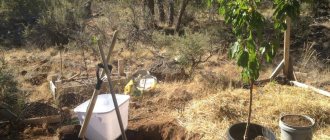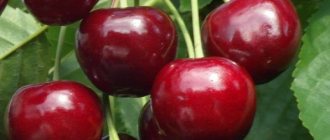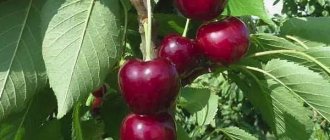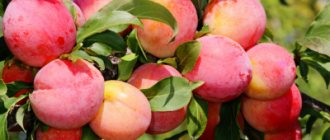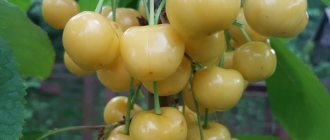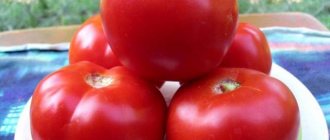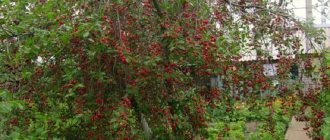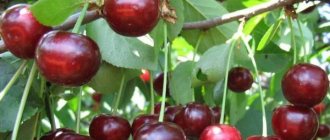Vegetable garden and more
Northern varieties of cherries
There are up to 4,000 varieties of cherries. All of them are divided into 2 groups - bigarro and guini . Bigarro is a variety with dense, elastic, crispy fruit pulp with colorless or slightly colored juice. They are used fresh and for processing, and are well transportable. Ghini - varieties with tender, juicy fruit pulp and almost colorless juice. They are poorly stored and cannot be transported. These are table varieties, mainly of early ripening.
The varieties bred for the middle zone are close to the southern ones in terms of fruit quality. Among the large-fruited ones (more than 5 g) are Adelina, Poeziya, Lena, Malyshka, Sadko, Lyubimitsa Astakhova, Iput, Revna, Raditsa, Tyutchevka, etc. In the Non-Black Earth Region, along with the already known varieties bred by VSTISP and the All-Russian Research Institute of Lupine - Fatezh, Chermashnaya, Iput , Revna, Tyutchevka, Podarok Stepanov, Bryanskaya pink, new varieties are becoming increasingly widespread - Bryanochka, Lena, Lyubimitsa Astakhova.
Keep in mind: cherry seedlings are often sold from the south of Russia, Ukraine and Moldova. These varieties are characterized by large fruits with a dessert taste, but they are not suitable for cultivation in most regions of our country. A harsh winter can lead to severe freezing and even death. Do not buy planting material on the market from random people.
Advantages and disadvantages
Sereshny variety "Krasnaya Gorka" has a number of advantages and some disadvantages. Let's look at them.
The advantages that will convince you to buy this particular “bird berry” are:
- Excellent taste characteristics of the product.
- Large fruit size.
- Excellent frost resistance.
- Good immunity to coccomycosis, moniliosis, holey spot and other diseases, as well as insect pests.
- Abundant yield.
- A special aesthetic appearance of both the tree itself and the fruit.
- Cherry berries have many beneficial and even healing properties.
- Wide application of fruits.
- Easy to care for (does not require frequent watering, fertilization, there is no urgent need for pesticide treatment)
- Low growth of the tree, which makes harvesting easier.
- Durability.
Unfortunately, Krasnaya Gorka has some disadvantages:
- Not suitable for winter preparations.
- Poorly transportable.
- “Reacts” negatively to excess moisture.
- “Afraid” of the wind.
- Requires pruning.
- It is not a self-fertile plant.
- The berries may cause an allergic reaction in some people.
- It has a short shelf life and, accordingly, is not suitable for industrial use and sale.
The “Krasnaya Gorka” cherry variety is not a perfect and universal plant, but if you create good conditions, this small tree will certainly delight you with an immodest and delicious harvest. It is best to purchase seedlings from official nurseries to avoid receiving defective varieties that will not bear fruit.
Cherry orchard in the non-black earth region
Posted by Leks » 01/19/2007, 21:19
Passed away Messages: 32043 Registered: 03/10/2006, 13:13 From: Moscow, railway station “PKH”, dacha 40 km along Yaroslavka Thanked: 101 times
Status: Offline
Message from Tamara » 01/19/2007, 23:34
Passed away Messages: 32043 Registered: 03/10/2006, 13:13 From: Moscow, railway station “PKH”, dacha 40 km along Yaroslavka Thanked: 101 times
Status: Offline
Message from Tamara » 01/19/2007, 23:40
weather forecaster Messages: 10807 Registered: 12/11/2006, 19:04 From: Moscow Thanked: 252 times Thanked: 1863 times
Status: Offline
Message from Charlie 83 » 01/20/2007, 19:08
Messages: 17 Registered: 01/18/2007, 22:04 From: Venev
Status: Offline
Posted by Leks » 01/21/2007, 11:38
Description of varieties
Let us dwell on the description of some new varieties of cherries, included over the past three years in the State Register of Breeding Achievements and recommended for cultivation in the Central and Central Black Earth regions of Russia.
Adeline
Medium ripening variety. The tree is medium-sized (up to 3.5 m). The fruits are large (5.5–6.0 g), heart-shaped, dark red, gristly, with a dessert taste (4.7 points). Self-sterile, the best pollinators: Poetry, Rechitsa, Teremoshka. Winter hardiness of flower buds is average. Relatively resistant to coccomycosis and moniliosis. Productivity is above average (15–20 kg per tree). The tree's winter hardiness is good. The variety was recommended for cultivation in the Central Black Earth region of the Russian Federation in 2009.
Bryanochka
Late ripening variety. The tree is medium-sized, with a round-oval, sparse crown. The fruits are above average size (4.7 g), dark red, juicy, sweet (taste 4.7 points). Self-sterile, the best pollinators: Tyutchevka, Iput. The average yield is 15–20 kg per tree. Resistance to coccomycosis is high, and resistance to pyasterosporia and moniliosis is average. The variety is recommended for cultivation in the Central region of the Russian Federation in 2009.
Late ripening variety. The tree is medium-sized. The crown is round-oval, raised, of medium density. The variety is self-sterile. The best pollinators: Revna, Iput, Tyutchevka, Ovstuzhenka. Fruits mainly on bouquet branches. The fruits are large (average weight 6, maximum - up to 8 g), dark red. The pulp is dense. The stone is medium, easily separated from the pulp. It begins to bear fruit in the 4th year after planting. The average yield is 20–25 kg per tree. A variety for universal use. Resistance to coccomycosis is good; it is not affected by moniliosis and clasterosporiasis.
Astakhov's favorite
Medium ripening period. The tree is medium-sized. Winter hardiness is high. The variety is partially self-fertile. The fruits are medium-sized (4.2 g), oval-shaped, pink, with a dessert taste. The variety is relatively resistant to coccomycosis and moniliosis. The average yield is 10 kg per tree. The variety is recommended for cultivation in the Central region of the Russian Federation in 2011.
Orlovskaya pink
Medium ripening variety. A tree of medium vigor, up to 3.5 m in height, the crown is pyramidal, flat, raised, of medium density. The fruits are pink, medium size (3.5–4.0 g). The bone separates from the pulp well. Tasting assessment of fresh fruits – 4.4 points. Dessert variety. It begins to bear fruit in the 3rd year. Fruits on bouquet branches and growth from last year. The variety is self-sterile. The best pollinators: Adeline, Poetry, Rechitsa, Teremoshka. The winter hardiness of the tree is average, the flower buds are high. The variety is relatively resistant to coccomycosis and moniliosis. The average yield is 11 kg/tree, the maximum is 16. Recommended for cultivation in the Central Black Earth region of the Russian Federation in 2010.
Motherland
Early ripening variety. A tree of medium vigor with a pyramidal crown. The fruits are large (4.5–5.0 g), dark burgundy, dense, gristly, dessert taste (4.5 points), universal purpose. Productivity is high (20–30 kg per tree). The variety is resistant to coccomycosis and moniliosis. Recommended for cultivation in the Central Black Earth region of the Russian Federation in 2010.
The following varieties are being tested at state variety plots in the Central and Central Black Earth regions: Sinyavskaya, Severnaya, Gastinets, Moskvoretskaya, Orlovskaya Fairy, Podarok Orlu, etc. After studying, they can replenish the existing cherry assortment.
Northern varieties of cherries can be successfully grown in central Russia, but it is necessary to remember and, if possible, fulfill the requirements of the crop for growing conditions. Then undoubted success awaits you.
Variety Sweetheart
Sweetheart cherry fruits
This cherry will ripen by the middle or end of August, which is much longer than the ripening time of other varieties. The tree is vigorous and spreading. The yield is quite high.
- the shape of the berries is heart-shaped;
- their color is dark red;
- the berries are large and quite dense;
- light red flesh is sweet and juicy;
- the berry can weigh from 8 to 12 g;
- The cherry seed of this variety is relatively small.
The fruits are distinguished by good transportability, do not rot or crack for a long time, and are not susceptible to diseases typical of cherries. The variety tolerates winter well. The fruits ripen within several weeks. This allows you to harvest gradually.
Half a century ago, cherries could only be found in southern latitudes. The climate has changed, and it has become much warmer in the northern regions. Breeders also did not sit idle, and now cherries are found much further north, where they did not exist before.
It is grown in central Russia, as well as in Belarus and the Baltic countries. Now it is not so difficult to grow and harvest a good harvest of sweet cherries.
The main thing is to choose the right seedling variety. Then you just need to follow the sequence of agrotechnical actions for caring for cherries.
Perhaps the descriptions given in this article will help everyone decide on the choice of a suitable variety of cherries.
Watch a useful video on how to choose the right cherry seedlings:
The sweetest and most delicious options according to experienced gardeners in Russia
For many lovers, size is not the main thing in fruits, since, first of all, their taste is valued. Over the past 15 years, more than 80 varieties have been developed with a sugar content above 5%, which is a very good indicator for such fruits. They immediately gained great popularity among summer residents and began to spread not only throughout Russia, but also to other countries. We bring to your attention the most prominent representatives of this class.
- Chereshnya Julia. It is a very tasty fruit that every summer resident who loves to eat sweets should grow. 5.9% sugar, more than 2% ascorbic acid make it extremely tasty and healthy. The flesh is firm, slightly crunchy. Over many years of cultivation in Russia, it has established itself as a reliable, proven, constantly fruiting option. Unfortunately, you won’t be able to collect a large number of berries from it, but you can count on 15-20 kg from one mature tree, both in a fruitful year and not so much. The crown is not spreading, the branches are directed upward and do not hang down, which significantly complicates harvesting in the middle of summer. Late (mid-late) cherries have excellent resistance to pests and diseases; only one treatment with pesticides against caterpillars is required throughout the entire season.
- Chereshnya Yaroslavna. If you want to grow a really tasty fruit at home or in the country, Yaroslavna is the best choice for this. The average sugar content is up to 14.2%, which is a record for domestic selection options . It is a worthy competitor to European trees, since, in addition to everything else, it produces up to 60 kg from one tree. That is why it has become the choice of many gardeners and farmers who are seriously involved in growing products for sale and export. Keeping quality is very good, does not crack when ripe, tolerates prolonged rains well, and can remain on the tree for a couple of weeks after technical ripening. All late cherry varieties cannot compare with it in this category, which is why it has earned such popularity in Russia.
- Ostozhenka cherry is another representative of the “delicious” category. It contains up to 13% sugars, at the stage of technical ripeness it has an unsurpassed taste, perfect for canning, preparing desserts, dishes, selling on the market (has excellent keeping quality) or simply for eating raw. This is where its advantages, perhaps, end. The disadvantages include low yield (harvesting 25 kg from one tree can already be considered a record), its poor resistance to frost (down to -20C), as well as weak biological protection against pests. It requires careful care, otherwise it will bear little fruit.
Application of fruits
The berries of the early variety of cherries are usually consumed fresh. They can be eaten as a dessert without adding sugar or honey, since the fruits contain plenty of glucose. Due to the attractiveness of the birdberry, it has become an integral element for decorating cakes, jelly and other desserts. Cherries work wonderfully as a pie filling. Restaurants quite often serve fruit sauce with meat. It can also be found in the bar menu: cocktails, liqueurs and liqueurs.
Cherry has also found its use in folk medicine. Due to the content of vitamins A, B, PP, E, as well as ascorbic, malic acid and carotene, cherries will be an excellent means of preventing spring vitamin deficiency. After all, “Krasnaya Gorka” ripens early. Experienced housewives know that properly prepared cherries are an excellent diuretic that is good for kidney diseases. It is believed that regular consumption of bird berries improves metabolism. Thus, you can lose weight, stabilize digestion and increase the overall tone of the whole body.
Cherries also contain anthocyanins - plant glycosides that help reduce inflammatory reactions of the intestinal walls, oxidative stress, and improve the barrier functions of the stomach with excess fats and carbohydrates. The fruits tone up and improve mood thanks to glucose. Krasnaya Gorka berries can strengthen capillary walls and prevent hypertension and dystonia. This is the prevention of atherosclerosis. Cherries also contain rare coumarins, which will lower the blood clotting threshold, prevent thrombosis and plaque formation, and have a good effect on the body in case of anemia. Berries are also commonly used as a pain reliever, especially for diseases such as gouty rheumatism, arthrosis, and joint problems.
Sweet cherries have many healing properties, but, of course, self-medication can harm your health, so be sure to consult with leading experts about its use as a medicine.
The largest fruited trees, their characteristics
If you want to grow fruits with excellent presentation and sell them at a higher price, then you need to pay attention to the following description of cherry varieties. They do not have any supernatural taste qualities, their yield is average or slightly above average, but the mass of fruits significantly exceeds ordinary berries. Here are several descriptions of the “heavyweights” in alphabetical order.
- Cherry Bull's heart. One of the largest-fruited, the weight of one berry can reach 8 grams, which is an unprecedented result for 90% of all results of domestic selection and foreign selection. The crown has a pyramidal appearance, and the natural neglect is slight. The only negative is that the fruits crack when ripe, especially if the weather outside alternates with a dry, hot wind. Great taste, slight sourness. It has a dark color and excellent presentation. It is poorly transported, shelf life is low, winter hardiness is high, and easily tolerates frosts down to -25 degrees.
- Daibera black cherry. It bears fruit only in the 5th year of growth, but immediately produces 7-9 kg per plant. By the 11th year it bears fruit in full and you can harvest up to 60 kg from one tree, due to this the yield per hectare reaches 90 centners. One of the biggest advantages of this tree is the size of the fruit - the average weight reaches 6.6 grams, which is quite a lot for this type of fruit. Sweet, up to 12% sugar, at the stage of technical ripeness has a black color, as well as a characteristic odor, which is much stronger than usual. It is in great demand on the market, as it has an excellent presentation, is easily transported and lasts for several weeks. It does not crack in normal weather, but during rain some fruits may crack if the fruit is ripe. Daibera is superior to the best cherry varieties of European selection, especially in terms of fruit weight. This is a “must have” for every summer resident!
- Italian. It is difficult to imagine early varieties of cherries without this bright representative, whose fruit weight is 6.8 grams, with some fruits weighing 8 grams. A worthy competitor to the best Dutch options, which is extremely popular in Russia, Belarus, Kazakhstan and Iran. It is grown in temperate climate zones and hotter regions, does not require large amounts of water and fertilizers, and produces stable, albeit small, yields. Up to 80 c/ha can be harvested even in drought and lean years. That is why it is recommended for industrial cultivation. Resistance to pests is excellent, although the keeping quality of the fruit leaves much to be desired - they rot in a few weeks and are poorly transported at the stage of technical ripeness.
Large-fruited varieties, as a rule, have low resistance to insect pests and do not tolerate sudden temperature changes. They are noticeably weaker and difficult to take root, so if you are planning to breed them and want to surprise your neighbors with huge fruits, you will have to work hard. All specimens begin to bear fruit in the 4th year, sometimes earlier you can get several berries per tooth.
Early varieties of cherries for the Moscow region
For those who prefer early varieties of cherries, you should pay attention to the ones described below.
Raditsa
It stands out for its very fast growth. The tree grows up to 4 meters high and begins to bear fruit at 5 years of age. The berries are slightly elongated, dark in color. When fully ripe, they are almost black, weighing up to 6 grams. The assessment of the taste qualities of this cherry variety is 4.5 points. Harvesting is easy. Withstands winter temperatures down to -35 degrees below 0. Excellent immunity to coccomycosis and moniliosis. The yield is 6 kg per 1 m2.
Chermashnaya
A fairly tall tree up to 5 meters has an oval crown of medium density. The shape of the berries is oval. The color of the cherry is yellow with the presence of a slight blush.
Photo of cherry variety Chermashnaya
The pulp is very juicy and sweet. The variety is suitable for fresh consumption and processing. Resistant to fungal attack. The best pollinator is the Iput cherry.
Gronkavaya
It ripens early, already in June. Fruiting occurs in the 4th year. For pollination, it is worth placing Zhurba or Iput nearby. Plant height up to 5 meters. The berries are heart-shaped and have a rich dark ruby color. The weight of one is 4.6 grams. Taste rating: 4.8 points out of 5. The variety has good immunity. Harvest from 1 m2 – 10 kg.
The highest yielding varieties in alphabetical order
For you, the main thing is high yield and solid profit from one tree? Then this category of trees is right for you. From 1 hectare you can harvest up to 15-30 tons, despite the fact that record yields are collected in Iran (55 t/ha). The following varieties yield up to 50-60 kg per tree, making them the best options for subsequent sale of products to the market or to wholesale outlets.
- Cherry Ovstuzhenka. An unusual fruit from the point of view of many gardeners is the black cherry, and its shape is cone-shaped. One of its main advantages is high yield - up to 115 centners on average and 250 maximum. With good care and abundant watering, it can easily produce up to 50 kg from one tree, and this is far from the limit. The sugar content is 11%, which also makes it one of the sweetest and most delicious in the Russian Federation and other neighboring countries. The crown is spreading, wide, the branches bend down under the weight of the fruit, in some cases supports are required, since in high winds they break off - this is perhaps the only disadvantage of this variety. Frost resistance is average - can withstand up to -25 degrees throughout the winter.
- Cherry variety Revna. Very recognizable in Russia, it has a light skin and dense flesh. Due to its yield of up to 30 t/ha, it has become one of the best options for domestic farmers. Revna cherries, reviews of which you can hear from every gardener, tolerate frost well, even at -5 degrees in April the color does not fall off, therefore it is recommended for cultivation in colder regions than the temperate climate zone. The crown is spreading, the tree grows tall, so it is recommended to pinch the top to form a suitable option for industrial use. By growing the Revna variety, you will always have cherries, even in the leanest year, since the stability of fruiting is greater than that of other varieties.
- Cherry Fatezh. Quite an interesting specimen, which was bred quite recently. Annual seedlings grow straight up, forming a peak-shaped crown, after which for the next 4-5 years they bend down and hang down to the ground, thereby significantly increasing the convenience of harvesting. It produces up to 60 kg from a 10-year-old tree, for which it has received very high marks from many gardeners who grow it. High winter hardiness and indifference to sudden temperature changes in the spring made it number 1 among high-yielding options. It should only be grown close to other trees for high-quality pollination. Early cherries ripen at the beginning of June or even at the end of May, depending on the temperature of the year.
Characteristics of the variety
The Krasnaya Gorka variety was bred at the All-Russian Lupine Research Institute in Bryansk by breeder M.V. Kanshina. The sweet cherry was obtained by crossing the Leningradskaya Chernaya and Compact Venyaminova varieties. Zoned in the Central region. It is frost-resistant: an adult tree can tolerate temperature drops of up to 30 °C.
Ripening period is early. Blooms in the first ten days of May. Fruits from 4 years of age. The berries are harvested in mid-July. The variety is promising, the yield is average. If agricultural practices are followed and in good conditions, up to 45 kg of berries are harvested from an adult tree per season. Transportability is average, due to the fact that the fruits are soft and very juicy. To transport over long distances, refrigerators and high-quality packaging are required. Table variety.
The variety is self-sterile, cross-pollinated.
The best pollinators are: Raditsa, Bryansk pink, Ovstuzhenka. For a more abundant harvest, it is recommended to plant 2-3 pollinator trees at a short distance from each other. Cherry is also suitable as a pollinating neighbor.
Variety Cordia
We all love cherries for their unique taste. But few people know what beneficial properties this summer berry has. Cherry fruits contain elements necessary for the body such as calcium, magnesium, phosphorus, iron and many others.
There are especially many of these substances in dark varieties. Cherries have the following beneficial effects on the body:
- the walls of the capillaries become strong and elastic;
- suppresses manifestations of atherosclerosis;
- helps with diseases such as anemia and hypertension.
We suggest you read: Temperature for broiler chickens: regime and climate for chickens
There are a lot of varieties of cherries. There are black cherries, red berries and yellow berries; nowadays there are more than 1000 of them. Below are descriptions of three good varieties of cherries: Cordia, Red Hill and Sweetheart.
Cherry fruits of the Cordia variety
The weight of each berry can be from 8 to 10 g. Cordia fruits are heart-shaped, their color is carmine black. The peel has a light bronze tint. They are distinguished by dense, aromatic dark red pulp.
The variety is resistant to frost and resists diseases well, begins to bear fruit early, and bears fruit abundantly and regularly.
Distinctive features of the berries:
- do not crack after rains;
- not subject to rotting;
- do not deteriorate during transportation.
Cherry of this variety produces many shoots, the spherical shape of which does not interfere with the pollination process. Cordia does not require any special conditions for growing cherries.
Cherry variety "Kordia" has an average ripening period. She will sing in the second ten days of July.
The weight of each berry can be from 8 to 10 g. Cordia fruits are heart-shaped, their color is carmine black. The peel has a light bronze tint. They are distinguished by dense, aromatic dark red pulp.
Advice from the gardener: the variety should be chosen if for no other reason than that during harvesting you should not rush too much; a delay will not lead to the destruction of the crop.
Description of the tree
According to the description, the Red Gorka cherry is a low-growing tree with a wide-round crown shape. The root system is horizontal, with some vertical shoots. Abundant fruiting from 6 to 12 years. At the age of 16 years, the tree is considered old and not suitable for exploitation due to small yields. The leaf is green, elliptical, pointed, and large in size. Petiole length 15 cm.
The arrangement of branches is whorled. The crown develops quickly and is prone to thickening. For prevention, pruning is recommended every spring from the age of 3 years. Vegetative, generative and mixed buds are formed on the tree.
Fruiting occurs on annual branches and bouquet shoots.
The flowers are bisexual and light in color. They bloom shortly before the leaves. Each flower has 5 petals, many stamens and one pistil. Fruit ripening is uneven and continues until the end of June.
Self-fertile cherry varieties for the Moscow region
These varieties do not require outside pollination and were created specifically for the Moscow region, taking into account the climate in its territory.
Homestead yellow
Self-pollinating cherry variety for the Moscow region. And self-fertility is one of the main advantages of this variety, since it is rare among the cherry crop. Its fruiting occurs on a constant basis, the yield is always approximately the same. In rainy weather, cherries do not crack. The berries are tasty and juicy, weighing about 5 grams. Color yellow.
Pridonskaya
The variety is distinguished by very spreading trees with a dense crown. The fruits are small, weighing 4.5 grams. The shape of the berries is oval and fairly smooth, with a red skin. Inside is tender and sweet pink flesh, with medium density.
Photo of the Pridonskaya cherry variety
There is a slight sourness in the taste. Sweet cherries are good for consumption fresh, as well as processed. Refers to early varieties of cherries suitable for the Moscow region. Resistance to low temperatures is average. Productivity – 15 kg per 1 m2.
People's Syubarova
The tree is vigorous with powerful branches that can easily withstand even strong winds. It can grow on depleted soil, as well as on loam and sandy loam soil. The size of the cherries is average. The color is bright red with gloss. The berries themselves are small with an excellent sweet taste.
This self-fertile variety can be grown in the Moscow region and does not require pollinators at all. The harvest is harvested in the second half of July. And the first fruiting occurs in the 3rd - 4th year after planting the seedling. Productivity is approximately 18 kg per tree.
Growing
Like other varieties of cherries, Krasnaya Gorka trees prefer breathable and fertile soil. Its acidity should be as close to neutral as possible. The planting hole must be prepared in a dry, warm place, out of reach of cold northern winds. The south side of buildings, fences, and slopes is suitable. Sweet cherries do not like high groundwater levels, therefore, if a similar problem exists on a site, seedlings are planted in prepared bulk hills to avoid rotting of the root system.
For this variety, spring planting is preferable, so the plant will have time to gain strength for the winter period.
- Into a planting hole prepared in the fall, measuring 60 cm deep and 80 cm wide, into which humus and ash were added.
- At the time of planting, the seedling is placed in the hole with the graft on the south side.
- The height of the root collar is 5 cm above the ground.
- The roots are straightened, covered with soil, filled with 2 buckets of water, and mulched.
- The seedling is tied to a support so that the trunk grows evenly and does not break from the wind.
- For the winter they are covered with spruce branches and lutrasil.
To ensure proper development of the seedling and obtain the maximum volume of fruit, a set of measures is carried out.
Watering
During periods of drought, young trees are watered once a week, in the circle around the trunk. When the tree grows and the crown expands, a furrow is made around the perimeter for irrigation. In dry weather, during fruit ripening, add 3 buckets of water once a week.
Fertilizer
They are fed in the second year after planting. Nitrogen fertilizers are applied in the spring, potassium fertilizers during the flowering period in the summer, and fluorine-containing fertilizers in the fall (description of doses in the instructions).
Trimming
Sanitary pruning is carried out as necessary. After the harvest is harvested, the shoots are cut by a third - this stimulates the formation of new fruit buds. In the northern regions, such manipulations are carried out every other year.
Bark protection
To prevent sunburn, in the fall and at the end of winter, the trunk and skeletal branches are treated with whitewash. In May, the trunk is furrowed; for this, cuts 15 cm long are made at a distance of 10 cm with a sharp knife, which helps protect against rupture of the bark.
Cherry varieties for the Moscow region - reviews on cultivation
Alevtina Viktorovna, Moscow region. For growing here in the Moscow region, I chose the early ripening cherry hybrid Nochka. It ripens in average terms. I like that fruiting occurs already in the 2nd year after planting the seedlings. And you don’t have to wait 5 or even 6 years, as with many varieties of cherries. The first harvest was very pleasing with large fruits of a deep ruby hue. The pulp is dense. Despite the fact that the tree is not tall, the yield is good, up to 20 kg. I recommend.
Olesya Igorevna, Bronnitsy Two years ago we planted Iput cherries. Excellent quality harvest. For some reason, there was a slight sourness in the taste, although it was not indicated in the description of the variety. I liked it even better. The results are very tasty. I especially recommend this variety of cherries for the Moscow region.
Vladimir Aleksandrovich, Moscow region For a long time we were looking for which variety of cherries was best to plant in the Moscow region. We needed it to be short so that it would not take up much space on the site, as there are other plantings. We chose the Krasnaya Gorka variety. In my opinion, this is an ideal option: it ripens early, does not get sick, the berries are tasty, and have an unusual yellow and blush color for cherries. An excellent low-growing, self-fertile variety for the Moscow region.
Diseases and pests
The variety is resistant to pests and diseases. Prevention is carried out in dry, windless weather before the start of sap flow. For spraying, prepare a 3% solution of Bordeaux mixture. To do this, dilute 300 g of copper sulfate in 1 liter of water and pour in a thin stream, mixing with white milk of lime (400 g per 9 liters of water). After flowering begins, spraying is repeated, but with a 1% solution, for which 100 g of copper sulfate and 150 g of lime are diluted in 10 liters of water according to a similar scheme.
The preparations “Zircon” and “Epin” have also proven themselves to be effective in spraying trees to protect them from weather conditions.
Red slide cherry characteristics
seeds nuts cereals
- Home / Uncategorized /
- Red slide cherry
Red slide cherry
Sweet cherry is the oldest representative of the cherry culture. It has become known for its importance to beekeeping as it is an excellent source of nectar for insects. Its fruits are known for their characteristic honey taste, and the price per kilogram of these berries is much higher than that of cherries. Cherry Krasnaya Gorka stands out among other varieties with its unique berry color - golden with a scarlet blush.
Description of fruits
The cherry fruit is large, gaining a weight of 5-6 g during ripening. The berry has a classic round shape. The fruits are known for their unusual color: golden with a scarlet blush, they look very attractive both on branches and in desserts. The skin is even, smooth, glossy. The pulp of the berry has no pigment, it is juicy, dense, soft, and easily separated from the small seed.
The fruits are very tasty, sweet with a slight sourness. They are densely located on the branch, like a crown.
Did you know? The composition of cherries includes: 82% water, 16% carbohydrates, 1% protein. They contain virtually no fat, only 0.2 grams of lipids per 100 grams of product. They are believed to contain fewer nutrients than cherries.
general characteristics
Sweet cherry, like cherry, is a member of the Rosaceae genus. Sweet cherries have a number of advantages over sour cherries. Thanks to the large crown and very bright berries, it has a presentable appearance not only in the spring, during the flowering period, but also in the summer, during the fruiting period. Red hill grows well in windless areas. Does not tolerate highly acidic soil and does not like close proximity to groundwater. The crown develops very quickly and always becomes too dense.
A special feature of the Krasnaya Gorka variety is the density of the berries.
The tree is self-sterile. For pollination, it is necessary to plant at least 3 trees with the same flowering dates. The best pollinators for this variety:
Neighborhood with cherries will be very effective.
Description of the tree
The tree of the Krasnaya Gorka variety is weak-growing, its maximum height reaches only 2–3 m. The variety is characterized by rapid development.
The crown of the tree is very dense and wide, ovoid in shape. The bark is brown or reddish in color, prone to peeling in transverse thin films.
Cherry Red Hill can have two types of shoots: auxiblast or brachyblast. The roots grow horizontally, but from time to time vertical roots appear. A distinctive feature of the variety is the leaves, which resemble an ellipse with a pointed end. The foliage is green and large. Cherry has petioles up to 16 cm long, the branches of the tree are arranged in whorls.
The buds can be vegetative, generative or mixed and, depending on the type, are located on growth and fruiting shoots.
Flowers bloom before foliage appears, always bisexual, light in color. Each flower consists of 5 sepals, 5 petals, one pistil and many stamens. Collected in umbrellas.
Features of the fruit
Description of the fruits: the berries are very large, their weight reaches 5–6 g. The berries have a round shape. The color of the berries is unique: golden with a scarlet blush, looks great both on the branches and on a plate.
The skin is even, smooth, with a glossy sheen. The pulp is juicy, without pigment. Easily separates from the pit. Cherry fruits are sweet and have a barely noticeable sourness. The berries are densely located on the branches.
Positive and negative sides
The species in question, like all varieties of cherries, has its advantages and disadvantages. Among the positive qualities are:
- excellent taste of the fruit;
- large berry size;
- precociousness (fruits in the 4th year of life);
- high frost resistance;
- strong immunity to diseases and insects;
- excellent yield;
- decorative type of tree;
- beneficial properties of berries;
- wide range of fruit applications;
- easy tree care;
- small tree growth, which makes harvesting easier.
Because of pests, the tree weakens, which has a bad effect on productivity.
There are also some disadvantages:
- the fruits are unsuitable for winter harvesting;
- poor transportability;
- reacts poorly to excess moisture;
- does not tolerate wind;
- the plant is not self-fertile;
- The shelf life is very short.
Red dense sweet cherry description of variety photo reviews %
> Garden
Let's talk about cherries and describe their best varieties. There are sweet, slightly sour, crispy, soft, and different colors. Thanks to selection, new forms of this amazing tree are developed every year.
Cherry varieties: description and photo
To get a bountiful harvest, it is necessary to choose varieties taking into account the climate in a particular region. Thus, frost-resistant varieties are suitable for central Russia, but more heat-loving plants can be grown in Ukraine.
Unlike cherries, cherries ripen much earlier; their tasty and aromatic fruits can already be enjoyed in early summer - June. This is a real source of useful microelements (iron, iodine, potassium, magnesium, calcium). The fruits of the plant grow in the form of a single-locular drupe with a juicy pericarp.
Considering the late emergence of cherry fruit buds from a state of forced dormancy, the yield of this crop is characterized as stable. Another advantage of cherries is the presence of reliable protection from return frosts on the anthers and pistils, which cherries do not have.
The leaves of the fruit crop are very large in size, distinguished by an elongated oval or elongated obovate shape and brown glands on the petioles.
It is not so often possible to find self-fertile varieties on the market. They can be purchased by order from abroad. Popular hybrid forms include: Alex, Peter, Stella, Sandor, Sweet Hart.
Below is a list of the most popular cherry varieties with descriptions and photos.
And the way
- Average height
- Early fruit ripening
- High yield (up to 30 kg of berries are harvested from one tree)
- High taste (the fruits are black in color and have dark red juicy pulp)
- The berry is removed along with the stalk
- The harvest is not afraid of transportation
- High degree of resistance to fungal infections
- Tolerates low temperatures well (down to -28 degrees)
- Average rate of early fruiting (yields a harvest 5 years after planting)
- If there is too much moisture, the fruits will crack.
- The pulp is difficult to separate from the stone
According to reviews:
Valery Chkalov
- Early berry ripening
- Large fruit size (weight up to 6-8 g)
- High taste characteristics of the fruit (the pulp is dark red in color, juicy, semi-cartilaginous consistency)
- Dessert type
- Universal use of berries
- High degree of productivity (62 kg per tree on average)
- High level of frost resistance (-23.5 degrees
- Tallness (up to 5 m)
- Wet separation of the berry from the fruit, juice is released
- The level of precocity is average (yields a harvest in the 5th year)
- Self-sterile variety
- Average level of resistance to diseases, including fungal ones
Pollinators: Dnieper, Bigarro Burlat, Aprilka, June early Skorospelka
Revna
- The tree is medium-sized, compact
- The crown has no sharp forks
- Easy to care for
- The fruits have high taste and consumer qualities
- Due to the dense skin, the crop is transportable over long distances
- High level of frost resistance (up to -30 degrees)
- High degree of resistance to frost cracking and sunburn
- Wood resistance to fungal infections
- Average late ripening period
- Self-sterility
Its best pollinators: Raditsy, Compact, Iput, Venyaminova, Tyutchevka, Ovstuzhenki
Large-fruited
- Medium-sized tree
- The fruits are very large, weighing up to 18 g
- The taste is sweet and sour, the color of the fruit is dark red, the pulp is medium dense
- High product characteristics
- Increased frost resistance
- Dry stem separation
- Transportability indicator is good
- Not susceptible to moniliosis
- Resistance to drought, without loss of taste qualities of the crop
- Late ripening
- Self-sterile
The best pollinators: Bugaro Oratovsky, Surprise, Francis,
Vasilisa
- Mid-season
- The berries are very large, weighing up to 15 g
- The taste and commercial qualities are excellent (the fruits have a rich red color, glossy shine, the flesh is dense, fleshy, juicy)
- Tasting score 4.5 points
- Duration of fruiting 20 years
- Berries are subject to shedding during heavy rainfall
- Requires additional pollination
- Low degree of resistance to fungal diseases and garden pests
The best pollinators: Skorospelka, Burlat, Aprilka, Priusadivnaya, Bigarro early
The best varieties of cherries are a relative concept, since in warm regions - in Ukraine, in the south of Russia - more heat-loving plants are common, but residents of the Leningrad region and Moscow region need to select frost-resistant varieties.
Besides, some people like it sweet, while others like it sour; some are crispy, some are softer; there will be adherents of black cherries, pink, yellow, with a red barrel... There are a great many varieties of cherries! How not to get lost among this diversity and choose the best variety of cherries just for you - we’ll figure it out in this article.
Classification of cherries by ripening time
You can provide yourself with sweet juicy fruits for almost the entire summer - from the end of June to August. To do this, you need to create a collection in your garden of early-ripening varieties of cherries (ripen around the end of June), mid-ripening (ripen around mid-July) and late-ripening varieties (ripening in early August).
Early ripening varieties of cherries - Iput, Gronkavaya, Early Rozovaya, Valery Chkalov, Skazka, Chance, Rubinovaya Early, Electra, Ariadna, Chermashnaya;
Mid-season cherry varieties - Tyutchevka, Leningradskaya Rozovaya, Rechitsa, Revna, Fatezh, in memory of Chernyshevsky, Ovstuzhenka, Orlovskaya Rozovaya, Veda, Adelina, Poetry, Pink Pearl, Dneprovka, Dilemma;
Late-ripening varieties of cherries - Prestizhnaya, Leningradskaya black, Red dense, Bryanskaya Rozovaya, Orion, Romantika, Turovtsev's lyubitsa.
Classification of cherries by fruit color
Black (dark red cherry): Veda, Adeline, Tyutchevka, Bryanochka, Revna, Raditsa, Leningradskaya Black, Iput, Gronkavaya, Ariadna, Ovstuzhenka, Rechitsa, Michurinka;
Yellow cherries: Chermashnaya, Drogana yellow, Homestead yellow, Red dense (yellow cherries with a red side);
Pink cherries: Leningrad pink, Early pink, Oryol pink, Bryansk pink, Fatezh;
Orange Cherry: Pink Pearl;
Classification of cherry varieties according to taste
Sweet cherries: Michurinskaya, Raditsa, Ovstuzhenka, Tyutchevka, Rechitsa, Leningradskaya black, Chermashnaya, Iput, Gronkavaya, Bryansk pink, Ariadna, Revna;
Sweet cherries with sourness: Early pink, Poetry, Orlovskaya pink, Fatezh, Pink pearl.
Classification of cherries by pulp structure
Conventionally, according to the density of the pulp, cherries are divided into two groups - with tender, soft pulp (guini) or dense, crunchy (bigarro).
Varieties of guini cherries: Early pink, Orlovskaya pink, Lningradskaya black, Leningradskaya pink, Chermashnaya, Iput;
Bigarro cherry varieties: Michurinka, Poeziya, Fatezh, Rechitsa, Bryansk pink, Ariadna.
Description of cherry varieties with photos
Cherry variety Drogana yellow
Drogan yellow cherry
Yellow Cherry Drogana yellow is a mid-season frost-resistant variety of the bigarro group. The variety is highly adaptive and can grow in Belarus, the North Caucasus, and Central Asia. The fruits of the Drogana yellow cherry variety are heart-shaped, weigh 6-7 grams, the pulp is light yellow, the juice is almost transparent.
Source: https://mahnem-ru.ru/chereshnja-krasnaja-plotnaja-opisanie-sorta-foto/
Growing
It is better to plant cherries in early spring, in April, before the buds swell. The soil must be fertile, loose, and moisture-permeable. Sandy or loamy soil is suitable.
The depth of the hole for planting must be at least 80 cm, width - 1 m. Drainage must be poured into the bottom of the hole (especially when grown on wet soil), since cherries do not tolerate stagnant water. It is recommended to plant seedlings at a distance of 4–5 m from each other. It is better to plant cherries in an open place, otherwise the crown of the tree may shade and suppress other plants.
The hole should be filled 1/3 full with soil mixture, which consists of the following components:
- earth - 2 buckets;
- ammonium sulfate - 2 kg;
- superphosphate - 3 kg;
- wood ash - 1 l;
- potash fertilizers - 1 kg.
If the soil is clayey, you need to pour several buckets of sand into the bottom of the hole. If the soil is sandy - several buckets of clay. After this, add soil mixture to the hole. Before planting the seedling, you need to secure a post at the bottom of the hole, which will serve as a support for the tree. Make a mound in the center of the hole where to place the seedling, after straightening its roots. After this, you need to attach the seedling to the support and add soil, lightly compacting it from time to time. The neck of the seedling should rise above the soil at a height of 3–6 cm. After this, all that remains is to water it generously and mulch the ground with humus, peat or fallen leaves.
Prepare the hole for planting well, preferably in an open place
To maintain the health of the tree, you need to follow a few simple rules.
- Removing weeds and loosening the soil.
- Annual pruning of shoots by 15–20 cm.
- Pruning the crown in the spring from the 3rd to 5th year of the tree’s life.
- The nutrients that were in the planting hole will provide the cherries with everything they need in the first 3 years. After this time has expired, 200 g of urea should be added with irrigation in early spring. At the end of summer, it is recommended to add 400 g of superphosphate and 100 g of potassium sulfate.
Every year, feed the cherries with nitrogen-containing and complex mineral fertilizers.
Care
To maintain the health of the tree, you need to follow a few simple rules.
- Removing weeds and loosening the soil.
- Annual pruning of shoots by 15–20 cm.
- Pruning the crown in the spring from the 3rd to 5th year of the tree’s life.
- The nutrients that were in the planting hole will provide the cherries with everything they need in the first 3 years. After this time has expired, 200 g of urea should be added with irrigation in early spring. At the end of summer, it is recommended to add 400 g of superphosphate and 100 g of potassium sulfate.
Every year, feed the cherries with nitrogen-containing and complex mineral fertilizers.
Pest and disease control
Sweet cherries may encounter the following pests:
- Chafer;
- cherry moth;
- slimy sawfly;
- plum moth;
- pollinated aphid.
It is most effective to begin pest control in early spring after the onset of above-zero temperatures (April). To destroy pests that were able to survive the winter, you should treat the soil near the roots with a urea solution. For 10 liters of water you will need 0.7 kg of urea.
Sandy and loamy soils need to be mulched, especially in hot weather
During the season, once every 25 days, spray the tree with preparations that repel flying insects: Iskra-Bio, Fitoferm, Zdorovy Sad or their analogues. There are drugs that increase the tree’s resistance to pests and diseases: Zircon and Ecoberine.
Many gardeners wash tree bark in early spring using a solution of iron sulfate in a dosage of 20 g per 5 liters of lukewarm water. You should add 10 drops of ordinary office glue, which will help the substance stick to the tree trunk.
The descriptions of diseases of cherries and cherries are similar. They pose a great challenge to gardeners. If treated incorrectly, you can lose not only the harvest, but also the tree itself. To choose the right treatment, you need to find out exactly what disease the plant is affected by. Sweet cherries are more susceptible to fungal diseases such as moniliosis, coccomycosis and clasterosporiosis. When affected by fungal diseases, the tree withers, the leaves turn yellow and fall off, the bark bursts, and the fruits rot. To avoid infection, it is necessary to carry out disease prevention. Preventive measures:
- timely cleaning and burning of fallen leaves and rotten fruits;
- thinning the thickened crown;
- digging up soil in root areas;
- preventive spraying.
